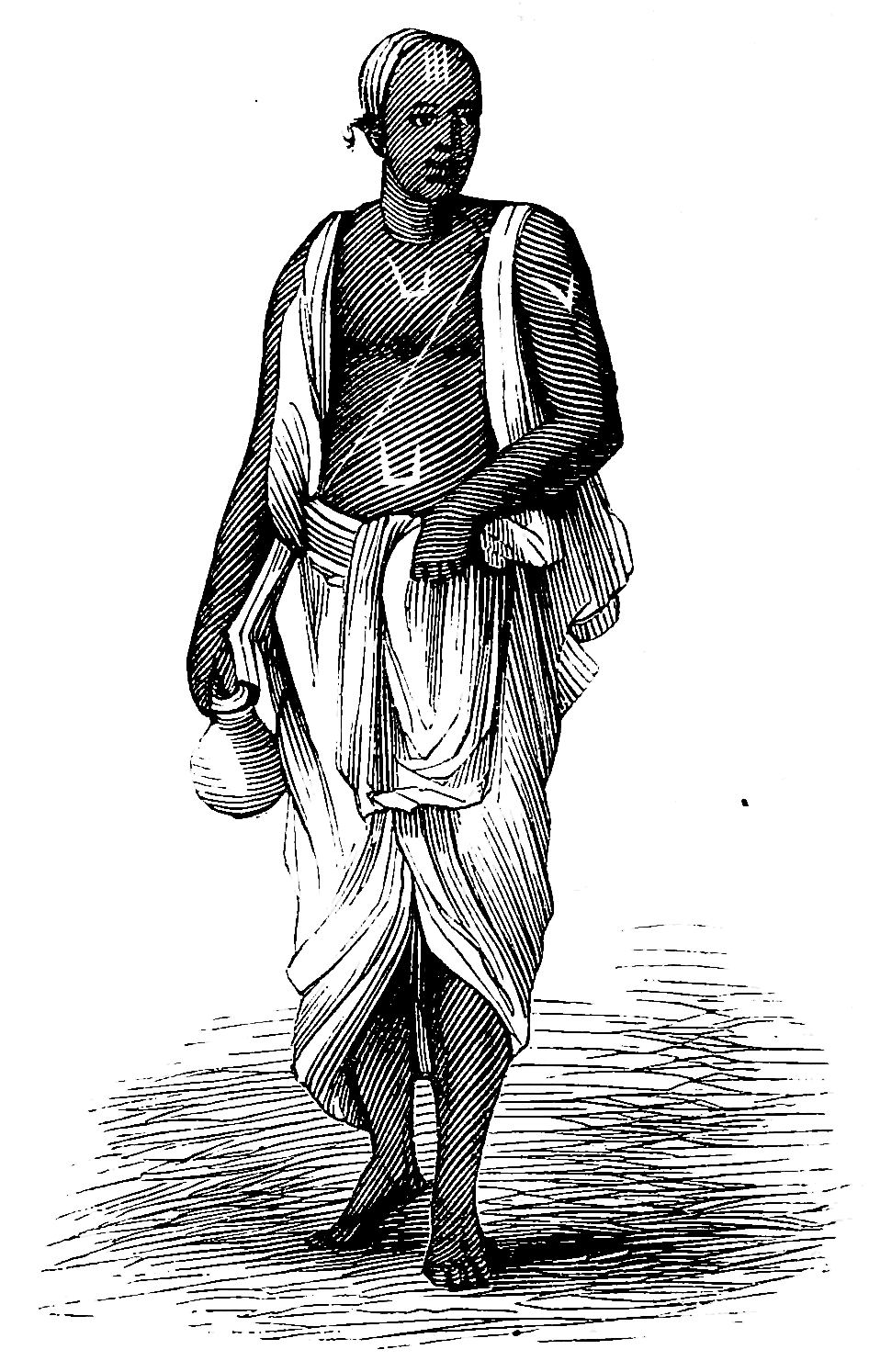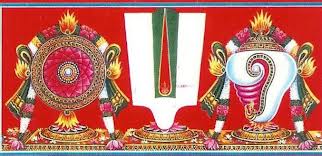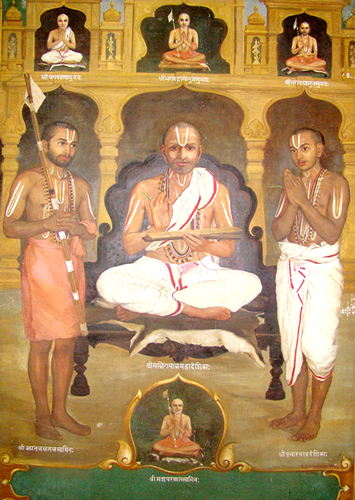|
Saranagati
Sharanagati (Sanskrit: ŗ§∂ŗ§įŗ§£ŗ§ĺŗ§óŗ§§ŗ§Ņ; IAST: ''ŇöaraŠĻáńĀgati'' ) or Prapatti (Sanskrit: ŗ§™ŗ•ćŗ§įŗ§™ŗ§§ŗ•ćŗ§§ŗ§Ņ; IAST: ''Prapatti''), is the process of total surrender to God (Narayana-Krishna) in the tradition of Vaishnavism. The process of Sharanagati forms the basis of devotion to Vishnu in the bhakti traditions within the Sri Sampradaya, propounded by Ramanuja (1017‚Äď1137 CE), and the Gaudiya Sampradaya, founded by Chaitanya Mahaprabhu (1482‚Äď1533 CE). Ramanuja considered surrender to Vishnu and his consort Lakshmi to be the highest goal of life, while Chaitanya emphasised surrender to Krishna and his consort Radha as supreme. Literature Sri Vaishnava texts offer their recognition of the practice of Sharanagati. Yamunacharya posited this approach as an alternative to the conventional practices of seeking salvation: Vedanta Desika's commentary on this sloka offers his perspective: Initiation The formal ritual of Sharanagati is a Vedic and Puranic scriptural and tr ... [...More Info...] [...Related Items...] OR: [Wikipedia] [Google] [Baidu] |
Yamunacharya
Yamunacharya (IAST: YamunńĀchńĀrya), also known as Alavandar and Yamunaithuraivan, was a Vishistadvaita philosopher based in Srirangam, Tamil Nadu, India. He is best-known for being a preceptor of Ramanuja, one of the leaders of the Sri Vaishnava tradition. He was born in the early 10th century CE, and was the grandson of Nathamuni, a famed yogi, who collected the works of the Tamil Alvars. Life Yamunacharya grew up learning Vedic texts from Rama Misra, and was skilled in the concept of mimamsa. According to Sri Vaishnava tradition, as a teenager, he challenged the royal priest of a Pandya king, Akkiyalvan, to a debate. Akkiyalvan, when he saw the age of the youth, sarcastically asked "''Alavandara''?", meaning "Has he come to rule me?". He defeated Akkiyalvan by logically proving that Akkiyalvan's mother was barren, the king was not righteous, and the queen unchaste. The king and queen, impressed that the boy had understood the shortcomings of logic, adopted him. The q ... [...More Info...] [...Related Items...] OR: [Wikipedia] [Google] [Baidu] |
Sri Vaisnava
Sri Vaishnavism, or the Sri Vaishnava Sampradaya, is a denomination within the Vaishnavism tradition of Hinduism. The name refers to goddess Lakshmi (also known as Sri), as well as a prefix that means "sacred, revered", and the god Vishnu, who are together revered in this tradition. The tradition traces its roots to the ancient Vedas and Pancharatra texts, popularised by the Alvars and their canon, the Naalayira Divya Prabandham. The founding of Sri Vaishnavism is traditionally attributed to Nathamuni of the 10th century CE; its central philosopher has been Ramanuja of the 11th century, who developed the ''Vishishtadvaita'' ("qualified non-dualism") Vedanta sub-school of Hindu philosophy. The tradition split into two denominations around the 16th century. The Vadakalai sect vested the Vedas with the greatest authority and follow the doctrine of Sri Vedanta Desika, whereas the Tenkalai sect vested the Naalayira Divya Prabandham with the greatest authority and follow the principl ... [...More Info...] [...Related Items...] OR: [Wikipedia] [Google] [Baidu] |
Vaishnavism
Vaishnavism ( sa, ŗ§Ķŗ•ąŗ§∑ŗ•ćŗ§£ŗ§Ķŗ§łŗ§ģŗ•ćŗ§™ŗ•ćŗ§įŗ§¶ŗ§ĺŗ§Įŗ§É, VaiŠĻ£ŠĻáavasampradńĀyaŠł•) is one of the major Hindu denominations along with Shaivism, Shaktism, and Smartism. It is also called Vishnuism since it considers Vishnu as the sole Para Brahman, supreme being leading all other Hindu deities, i.e. ''Mahavishnu''. Its followers are called Vaishnavites or ''Vaishnava''s (), and it includes sub-sects like Krishnaism and Ramaism, which consider Krishna and Rama as the supreme beings respectively. According to a 2010 estimate by Johnson and Grim, Vaishnavism is the largest Hindu sect, constituting about 641 million or 67.6% of Hindus. The ancient emergence of Vaishnavism is unclear, and broadly hypothesized as a History of Hinduism, fusion of various regional non-Vedic religions with Vishnu. A merger of several popular non-Vedic theistic traditions, particularly the Bhagavata cults of VńĀsudeva, VńĀsudeva-krishna and ''Gopala-Krishna, Gopala-Krishna'', and Narayana, ... [...More Info...] [...Related Items...] OR: [Wikipedia] [Google] [Baidu] |
Sri Sampradaya
Sri Vaishnavism, or the Sri Vaishnava Sampradaya, is a denomination within the Vaishnavism tradition of Hinduism. The name refers to goddess Lakshmi (also known as Sri), as well as a prefix that means "sacred, revered", and the god Vishnu, who are together revered in this tradition. The tradition traces its roots to the ancient Vedas and Pancharatra texts, popularised by the Alvars and their canon, the Naalayira Divya Prabandham. The founding of Sri Vaishnavism is traditionally attributed to Nathamuni of the 10th century CE; its central philosopher has been Ramanuja of the 11th century, who developed the ''Vishishtadvaita'' ("qualified non-dualism") Vedanta sub-school of Hindu philosophy. The tradition split into two denominations around the 16th century. The Vadakalai sect vested the Vedas with the greatest authority and follow the doctrine of Sri Vedanta Desika, whereas the Tenkalai sect vested the Naalayira Divya Prabandham with the greatest authority and follow the principl ... [...More Info...] [...Related Items...] OR: [Wikipedia] [Google] [Baidu] |
Urdhva Pundra
The Urdhva Pundra () is a tilaka worn by Vaishnavas as an indication of their affiliation with Vishnu. It is generally worn on the forehead, but may also be worn on other parts of the body such as the shoulders. The markings are made either as a daily ritual, or on special occasions, and denote the particular sampradaya'','' or the ineage to which the devotee belongs. The different Vaishnava sampradayas each have their own distinctive style of tilaka based on the siddhanta of their particular lineage. The general tilaka design is of two or three vertical lines resembling the letter U, which represent the feet of Vishnu. Literature The Urdhava Pundra has historically been associated with the Vaishnava tradition, just as the Tripundra has been associated with the Shaiva tradition. The Padma Purana explains the theological significance of this symbol: The Vasudeva Upanishad, a Vaishnava text, explains the significance of the three vertical lines in the ''Urdhva Pundra'' T ... [...More Info...] [...Related Items...] OR: [Wikipedia] [Google] [Baidu] |
Sri Vaishnavism
Sri Vaishnavism, or the Sri Vaishnava Sampradaya, is a denomination within the Vaishnavism tradition of Hinduism. The name refers to goddess Lakshmi (also known as Sri), as well as a prefix that means "sacred, revered", and the god Vishnu, who are together revered in this tradition. The tradition traces its roots to the ancient Vedas and Pancharatra texts, popularised by the Alvars and their canon, the Naalayira Divya Prabandham. The founding of Sri Vaishnavism is traditionally attributed to Nathamuni of the 10th century CE; its central philosopher has been Ramanuja of the 11th century, who developed the ''Vishishtadvaita'' ("qualified non-dualism") Vedanta sub-school of Hindu philosophy. The tradition split into two denominations around the 16th century. The Vadakalai sect vested the Vedas with the greatest authority and follow the doctrine of Sri Vedanta Desika, whereas the Tenkalai sect vested the Naalayira Divya Prabandham with the greatest authority and follow the princip ... [...More Info...] [...Related Items...] OR: [Wikipedia] [Google] [Baidu] |
Page 346 Life In India Or Madras, The Neilgherries, And Calcutta
Page most commonly refers to: * Page (paper), one side of a leaf of paper, as in a book Page, PAGE, pages, or paging may also refer to: Roles * Page (assistance occupation), a professional occupation * Page (servant), traditionally a young male servant * Page (wedding attendant) People with the name * Page (given name) * Page (surname) Places Australia * Page, Australian Capital Territory, a suburb of Canberra * Division of Page, New South Wales * Pages River, a tributary of the Hunter River catchment in New South Wales, Australia * The Pages, South Australia, two islands and a reef **The Pages Conservation Park, a protected area in South Australia United States * Page, Arizona, a city * Page, Indiana * Page, Minneapolis, Minnesota, a neighborhood * Page, Nebraska, a village * Page, North Dakota, a city * Page, Oklahoma, an unincorporated community * Page, Virginia * Page, Washington, a ghost town * Page, West Virginia, a census-designated place * Page Airport (dis ... [...More Info...] [...Related Items...] OR: [Wikipedia] [Google] [Baidu] |
Bhakti Movement
The Bhakti movement was a significant religious movement in medieval Hinduism that sought to bring religious reforms to all strata of society by adopting the method of devotion to achieve salvation. Originating in Tamilakam during 6th century CE, it gained prominence through the poems and teachings of the Vaishnava Alvars and Shaiva Nayanars before spreading northwards. It swept over east and north India from the 15th century onwards, reaching its zenith between the 15th and 17th century CE. The Bhakti movement regionally developed around different gods and goddesses, and some sub-sects were Shaivism (Shiva), Vaishnavism (Vishnu), Shaktism (Shakti goddesses), and Smartism.Wendy Doniger (2009)"Bhakti" ''Encyclopædia Britannica'' Bhakti movement preached using the local languages so that the message reached the masses. The movement was inspired by many poet-saints, who championed a wide range of philosophical positions ranging from theistic dualism of Dvaita to absolute moni ... [...More Info...] [...Related Items...] OR: [Wikipedia] [Google] [Baidu] |
Puja (Hinduism)
''Puja'' ( sa, ŗ§™ŗ•āŗ§úŗ§ĺ, pŇęjńĀ, translit-std=IAST) is a worship ritual performed by Hindus, Buddhists and Jains to offer devotional homage and prayer to one or more deities, to host and honor a guest, or to spiritually celebrate an event. It may honor or celebrate the presence of special guests, or their memories after they die. The word ''pŇęjńĀ'' is Sanskrit, and means reverence, honor, homage, adoration, and worship.ŗ§™ŗ•āŗ§úŗ§ĺ ''Sanskrit Dictionary'', Germany (2009) Puja, the loving offering of light, flowers, and water or food to the divine, is the essential ritual of Hinduism. For the worshipper, the divine is visible in the image, and the divinity sees the worshipper. The interaction between human and deity, between |
Archana (Hinduism)
''Puja'' ( sa, ŗ§™ŗ•āŗ§úŗ§ĺ, pŇęjńĀ, translit-std=IAST) is a worship ritual performed by Hindus, Buddhists and Jains to offer devotional homage and prayer to one or more deities, to host and honor a guest, or to spiritually celebrate an event. It may honor or celebrate the presence of special guests, or their memories after they die. The word ''pŇęjńĀ'' is Sanskrit, and means reverence, honor, homage, adoration, and worship.ŗ§™ŗ•āŗ§úŗ§ĺ ''Sanskrit Dictionary'', Germany (2009) Puja, the loving offering of light, flowers, and water or food to the divine, is the essential ritual of Hinduism. For the worshipper, the divine is visible in the image, and the divinity sees the worshipper. The interaction between human and deity, between |
Guru
Guru ( sa, ŗ§óŗ•Āŗ§įŗ•Ā, IAST: ''guru;'' Pali'': garu'') is a Sanskrit term for a "mentor, guide, expert, or master" of certain knowledge or field. In pan-Indian traditions, a guru is more than a teacher: traditionally, the guru is a reverential figure to the disciple (or '' shisya'' in Sanskrit, literally ''seeker f knowledge or truth'' or student, with the guru serving as a "counselor, who helps mold values, shares experiential knowledge as much as literal knowledge, an exemplar in life, an inspirational source and who helps in the spiritual evolution of a student". Whatever language it is written in, Judith Simmer-Brown explains that a tantric spiritual text is often codified in an obscure twilight language so that it cannot be understood by anyone without the verbal explanation of a qualified teacher, the guru. A guru is also one's spiritual guide, who helps one to discover the same potentialities that the ''guru'' has already realized. The oldest references to the concep ... [...More Info...] [...Related Items...] OR: [Wikipedia] [Google] [Baidu] |
Sudarshana
Sudarshana Chakra (Sanskrit: ŗ§łŗ•Āŗ§¶ŗ§įŗ•ćŗ§∂ŗ§® ŗ§öŗ§ēŗ•ćŗ§į, lit. "disc of auspicious vision", IAST: SudarŇõana Chakra) is a spinning, celestial discus with 108 serrated edges, attributed to Vishnu and Krishna in the Hindu scriptures. The Sudarshana Chakra is generally portrayed on the right rear hand of the four hands of Vishnu, who also holds the Panchajanya (conch), the Kaumodaki (mace), and the Padma (lotus). While in the Rigveda, the Chakra was Vishnu's symbol as the wheel of time and by the late period, the Sudarshana Chakra emerged as an ayudhapurusha (an anthropomorphic form), as a fierce form of Vishnu, used for the destruction of demons. As an ''ayudhapurusha'', the deity is known as Chakraperumal or Chakratalvar. Etymology The word ''Sudarshana'' is derived from two Sanskrit words ‚Äď ''Su''(ŗ§łŗ•Ā) meaning "good/auspicious" and ''Darshana'' (ŗ§¶ŗ§įŗ•ćŗ§∂ŗ§®) meaning "vision". In the Monier-Williams dictionary the word Chakra is derived from the root ŗ§ēŗ•ćŗ§įŗ ... [...More Info...] [...Related Items...] OR: [Wikipedia] [Google] [Baidu] |





.jpg)


